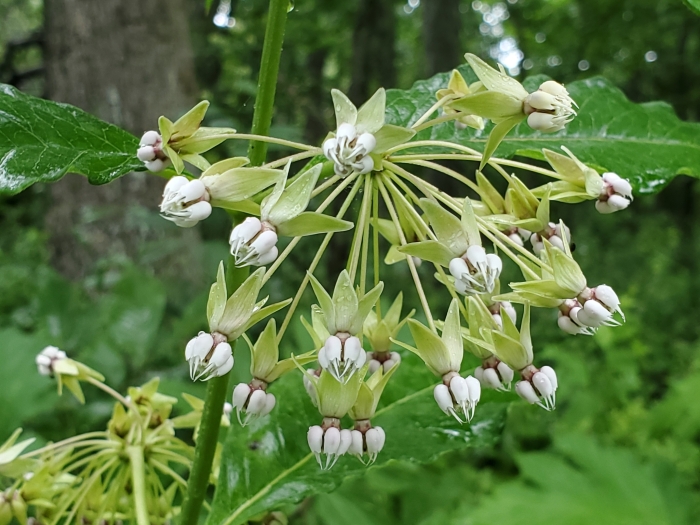Poke Milkweed
(Asclepias exaltata)
Poke Milkweed (Asclepias exaltata)
/
/

Craig Martin
Public Domain
Image By:
Craig Martin
Recorded By:
Copyright:
Public Domain
Copyright Notice:
Photo by: Craig Martin | License Type: Public Domain | License URL: http://creativecommons.org/publicdomain/zero/1.0/ | Rights Holder: Craig Martin | Publisher: iNaturalist | Date Created: 2021-07-01T13:25:41-07:00 |

















































Estimated Native Range
Summary
Asclepias exaltata, commonly known as Poke Milkweed, is a deciduous perennial herb native to the understory of deciduous forests, forest edges, and open woodlands in the Northeastern United States. It typically grows from 0.6 to 1.5 meters (2.0 to 4.9 ft) tall. The plant features clusters of drooping flowers that are greenish-white with purple accents, blooming from late spring to early summer. The flowers are quite showy and attract a variety of pollinators, including bees and butterflies. Poke Milkweed is particularly important as a host plant for the Monarch butterfly caterpillars.
Poke Milkweed is valued for its ability to attract wildlife and its adaptability to a range of light conditions, making it suitable for naturalistic plantings and wildlife gardens. It can be used in shaded borders or woodland gardens. This species prefers moist, well-drained soils but can tolerate drier conditions once established. It is relatively low maintenance but may require staking if grown in overly rich or moist soils. Gardeners should be aware that, like other milkweeds, it contains toxic compounds that can be harmful if ingested.CC BY-SA 4.0
Poke Milkweed is valued for its ability to attract wildlife and its adaptability to a range of light conditions, making it suitable for naturalistic plantings and wildlife gardens. It can be used in shaded borders or woodland gardens. This species prefers moist, well-drained soils but can tolerate drier conditions once established. It is relatively low maintenance but may require staking if grown in overly rich or moist soils. Gardeners should be aware that, like other milkweeds, it contains toxic compounds that can be harmful if ingested.CC BY-SA 4.0
Plant Description
- Plant Type: Herb
- Height: 4-5 feet
- Width: 6-8 feet
- Growth Rate: Rapid
- Flower Color: Purple, White
- Flowering Season: Summer
- Leaf Retention: Deciduous
Growth Requirements
- Sun: Full Sun, Part Shade
- Water: Medium
- Drainage: Medium
Common Uses
Bee Garden, Bird Garden, Butterfly Garden, Deer Resistant, Drought Tolerant, Fragrant, Hummingbird Garden, Low Maintenance
Natural Habitat
Understory of deciduous forests, forest edges, and open woodlands in the Northeastern United States
Other Names
Common Names: Tall Milkweed , Asclépiade Très Grande
Scientific Names: Asclepias exaltata , Asclepias nivea , Asclepias phytolaccoides , Asclepias bicknellii , Asclepias syriaca var. exaltata
GBIF Accepted Name: Asclepias exaltata L.